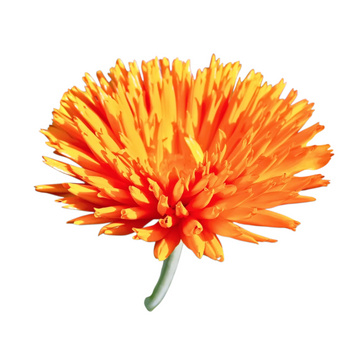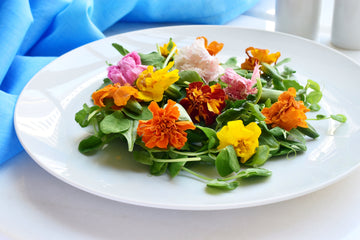Calendula Radio

Freshly Harvested

Non-GMO & Natural

Nutrient Dense

Trusted by Chefs
10 Seeds+
🌼 Calendula ‘Radio’ Edible Flowers
Calendula officinalis
Known as the “poor man’s saffron” 🌿✨, Calendula ‘Radio’ bursts with fiery orange, spiky-petaled blooms 🌞🔥 that light up gardens and plates alike. Historically prized in European and Mediterranean kitchens, this heirloom variety offers edible petals that bring both color and subtle flavor to food and drink. Hardy, long-blooming, and pollinator-friendly 🐝🦋 — an easy win for gardeners and chefs.
👅 Flavor Profile:
Mildly tangy 🍊, peppery 🌶️, and slightly bitter 🌿 — like a saffron-meets-marigold note.
🍴 Culinary Uses:
🥗 Sprinkle petals over salads for golden flair
🥘 Use as a saffron substitute in rice, soups & paellas (“poor man’s saffron”)
🫖 Steep in teas or infuse into oils for earthy depth
🧁 Decorate cakes, breads & pastries with vibrant orange petals
🍸 Float petals in cocktails or syrups for visual & herbal impact
👨🍳 Chef’s Pitch:
Calendula ‘Radio’ is the chef’s color bomb 🌼👨🍳💥. Brilliant orange petals transform ordinary dishes into gourmet presentations, while offering subtle earthy notes. A historical culinary flower used to tint broths, oils, and pastries — and a stunning edible garnish that chefs love for plating drama.
🌱 Growing Notes:
🪴 Hardy annual, 18–24” tall with bushy growth
🌼 Unique quilled “radio” petals in blazing orange
⏱ Blooms continuously from early summer until frost
🐝 Pollinator magnet + medicinal herb tradition
🧑🌾 Easy to grow in most soils, tolerates poor conditions
✨ Quick Facts:
-
Latin Name: Calendula officinalis (‘Radio’)
-
Habit: Annual, 18–24” tall
-
Flavor: Tangy, peppery, mild saffron-like notes
-
Culinary Uses: Garnishes, teas, saffron substitute, baked goods, syrups
-
Companion Planting: Repels pests, attracts pollinators, boosts soil health

Calendula Radio

Let’s Manifest Beauty.
Edible Flowers that Smile.
Edible flowers are more than just decoration — they’re a chef’s secret for adding elegance, fragrance, and subtle flavor to a dish. From citrusy marigolds to honey-sweet alyssum and tangy begonias, these delicate blooms transform plates into experiences. Each petal offers color, aroma, and taste, turning simple ingredients into a culinary statement.

Flowers are here to stay
The Art of Garnishing with Edible Flowers
A garnish should do more than decorate — it should enhance. Edible flowers bring color, fragrance, and subtle flavor to the plate, turning simple dishes into memorable experiences. From delicate petals scattered across a salad to a single bloom crowning a dessert, flowers add elegance and elevate presentation in ways that engage every sense.
The Secret Ingredient Chefs Trust
Widely used in professional kitchens, microgreens enhance flavor profiles while adding nutrition and a striking visual appeal to everything from sandwiches to fine dining creations.
Frequent Asked Questions
Q: What are Microgreens?
Microgreens are young, tender plants harvested just after the first leaves develop. They’re packed with flavor, color, and nutrients, making them both delicious and healthy.
Q: Are microgreens really more nutritious than regular vegetables?
Yes. Research shows that microgreens can contain up to 40x more vitamins and antioxidants (like A, C, K, and E) compared to their mature counterparts.
Q: How do I use microgreens in my meals?
They’re incredibly versatile—use them as a garnish, in salads, on sandwiches, in wraps, smoothies, soups, or even as a centerpiece ingredient in gourmet dishes.
Q: How long do microgreens stay fresh?
Stored properly in a fridge, microgreens typically last 5–7 days. To keep them at peak freshness, store them dry in a breathable container.










